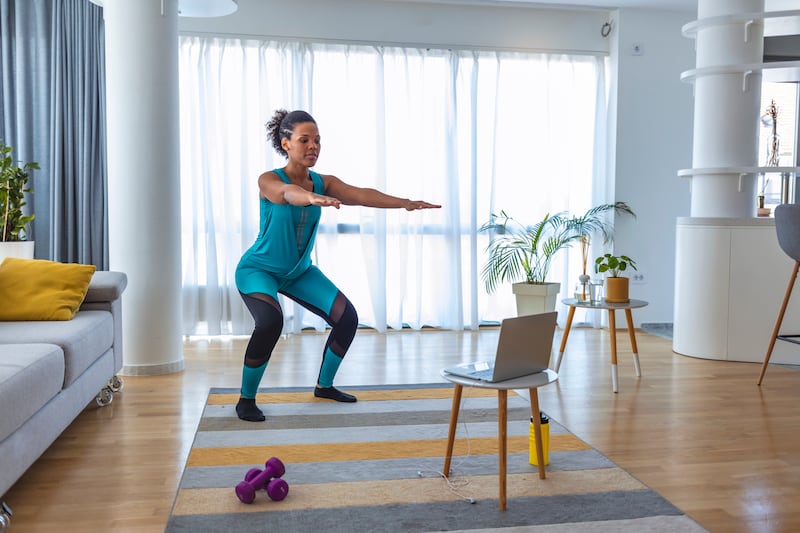
After Shari Berkowitz was injured during a live dance performance onstage, doctors told the actress that one wrong move could leave her paralysed for life. She had suffered three herniated discs in her neck, with one bulging into her spinal column. Months of physical therapy got her out of the danger zone, and then she discovered Pilates.
Though excellent doctors and physical therapists got her through the initial healing, she says Pilates gave her “strength and confidence in my ability to move – the confidence that I could move,” she says. The workout led to her full recovery and inspired her to become a Pilates instructor and studio owner herself. “Pilates was so transformative. When I see a client start to develop that same physical and emotional strength,” she says, “it’s extremely satisfying.”
Berkowitz is not the only Pilates devotee to speak about the workout’s transformative powers. Many studios tout a quote attributed to its founder, German boxer and strongman Joseph Pilates, that declares: “In 10 sessions, you feel better, 20 sessions you look better, 30 sessions you have a completely new body.”
While no workout can offer us a new body, devotees say the low-weight resistance training can help our current bodies in important ways, strengthening the core muscles around the spine. Pilates first gained widespread attention in the late 1990s, as celebrities such as Madonna and Uma Thurman touted its benefits, and aerobics enthusiasts sought a lower impact option.
READ MORE
But a few years ago, the workout appeared to be on the decline. Doomsayers predicted a “Pilatespocalypse,” as newer and sweatier fitness trends, such as spinning and boot camps, exploded.
But thanks in part to the pandemic, many people’s exercise priorities shifted from intense, calorie-burning workouts to activities that also foster a mind-body connection, says Cedric Bryant, president and chief science officer of the American Council on Exercise.
Pilates is once again booming. Most market researchers don’t track it separately from yoga, but the International Health, Racquet & Sportsclub Association ranked it as the most popular gym activity for women. It now includes a wide array of offerings, from small private studios with one-on-one instruction and national Pilates franchises to app-based virtual classes and amped up “power” Pilates.
So, is it worth trying to incorporate Pilates into your fitness routine? And what method is right for you? If you’re intrigued by the workout, here’s what you need to know.
What is Pilates?
Pilates workout is often performed on a mat or in a chair and includes many strength and flexibility exercises found in other forms of resistance training. “There’s nothing mysterious about Pilates,” says Alycea Ungaro, author of several guides to the method.
But there are a few elements that make Pilates unique. First, the method encourages participants to focus on breathing and cultivate a mind-body connection, paying particular attention to how all movement stems from the core. Exercises are repeated in sets that strategically work the muscles without exhausting them.

Many Pilates workouts also incorporate special equipment, including spring-based resistance machines designed to support the spine and target specific muscle groups. The most popular machine, called the “reformer”, looks like a small bed frame with a sliding platform hooked up to a system of springs, ropes and pulleys.
Scientific research supports an array of impressive health benefits for Pilates. Studies suggest it may help to improve muscle endurance and flexibility, reduce chronic pain and lessen anxiety and depression.
Who can benefit from Pilates?
The short answer is: everyone. Really. Pilates can be tailored to a spectrum of fitness goals, ages and abilities – professional dancers, athletes, pregnant women, octogenarians looking to improve their balance.
“Anybody can do it,” says Carrie Samper, director of Pilates education for Equinox. “You don’t have to be 25 and a Cirque du Soleil dancer. You can be 85 and start doing Pilates.”
While doing Pilates will bring rewards on its own, some people approach it as a complement to other physical activities. “It really taught me how to move my body,” says Chris Robinson, a martial artist and owner of a Pilates studio. “And I found I could apply that education to anything.”
Physicians and physical therapists often recommend Pilates as a path to rehabilitation for people recovering from injury. “It can serve as a bridge back to more normal activity,” says Bryant. It can also help reduce one’s odds of becoming injured, he says, because of its ability to improve core stability, balance, flexibility and posture. “We know that when those are inadequate, you increase your risk for a variety of musculoskeletal and joint injuries.”

Pilates can also benefit women who are pregnant or postpartum by safely strengthening the core and conditioning the pelvis. “It’s a great way to strengthen your pelvic floor without doing hundreds of Kegels,” says Sarah Clampett, a physical therapist. “Anyone with pelvic floor issues or dysfunction would benefit from Pilates.”
What can’t Pilates do?
Traditional Pilates is not a cardiovascular workout. “The more advanced a person is, the more cardio-like it is,” says Berkowitz, who now trains instructors through her online studio, the Vertical Workshop. “But you’re never going to get to the point where you are really challenging your cardiovascular system.”
It isn’t equivalent to lifting heavy weights, either. “There are limitations to how much strength it builds,” says Samper. “It’s not the same thing as doing trap bar dead lifts or bench presses. You’re not going to build that same muscle, because you never do Pilates movements to exhaustion.”
It’s also not the best workout for catching up with a friend or watching TV. “You have to be really present and pay attention to where your body is in space and what it’s doing, and not everyone wants to do that,” says Samper. Without that level of concentration, you likely won’t reap as many benefits – and could risk injury.
So how often should you do it?
While you will see benefits from doing Pilates once or twice weekly, exercise experts agree that the ideal is three times a week. That’s the “sweet spot”, says Samper.
Is there such a thing as too much Pilates? Not really, if you mix up the way you practise. “If you find that it’s the thing that kind of floats your boat, there’s nothing wrong with doing it as many as five times or more a week,” says Bryant.
What type of Pilates is best for you?
Not all workouts that call themselves “Pilates” are created equal.
Experienced Pilates instructors generally recommend starting with one-on-one or small group training sessions, so you can learn the basics. “The ideal situation is to be in the studio,” says Robinson. “You have all the apparatus to help you and an instructor to guide you.”
But for a lot of people, he says, that’s just not feasible. Individual training sessions can be expensive. “There’s still a lot to be gained virtually, if that’s all you can do,” says Robinson. “You know, some Pilates is better than no Pilates.”
The method you connect with can depend on your specific goals and needs. “If you’re a healthy person and you don’t have any musculoskeletal issues – you just want a good workout – absolutely, go join a gym Pilates class,” says Carrie Lamb, a Pilates instructor and physical therapist. But if you’re recovering from an injury or dealing with chronic pain, you may benefit from a more intimate environment.
For people looking for a workout that helps them achieve both cardio and muscle-building goals, consider checking out newer, hybrid Pilates offerings that speed up classical movements and promise to get your heart pumping.
Finding the right instructor is crucial
To benefit most from Pilates, seek out “a well-trained and qualified instructor” who puts clients’ safety first, says Bryant.
As Pilates has become more popular, more people with very little training are marketing themselves as Pilates instructors. “There are some people who will tell you that they teach Pilates, and they’ve gone to a weekend class,” says Lamb, while others “have gone through comprehensive training and spent hundreds of hours and thousands of dollars to learn.”
Before you sign up for any form of Pilates, check out the credentials of the instructor. Ask the prospective instructor how they can help you meet your specific goals. Find someone who will carefully listen to you and understand you as an individual, says Bryant, “as opposed to being the expert who’s going to tell you what you need”.
– This article originally appeared in the New York Times. Danielle Friedman is a journalist in New York city and author of Let’s Get Physical: How Women Discovered Exercise and Reshaped the World













